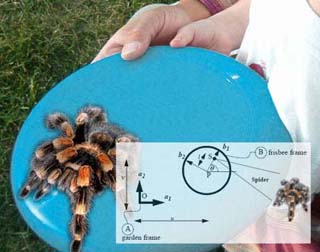
Multiple frames of reference help explain the position, velocity and acceleration of a spider on a spinning frisbee. See the video for lecture 2 and the reading on kinematics for more on this introductory problem. (Frisbee photo courtesy of Crys Mascarenas; spider photo courtesy of B. Smith. Collage by MIT OpenCourseWare.)
Instructor(s)
Prof. Nicholas Makris
Prof. Peter So
Prof. Sanjay Sarma
Dr. Yahya Modarres-Sadeghi
MIT Course Number
2.003J / 1.053J
As Taught In
Fall 2007
Level
Undergraduate
Course Description
Course Features
- Selected video lectures
- Assignments: problem sets (no solutions)
- Assignments: programming with examples
- Exams (no solutions)
Course Description
This class is an introduction to the dynamics and vibrations of lumped-parameter models of mechanical systems. Topics include kinematics; force-momentum formulation for systems of particles and rigid bodies in planar motion; work-energy concepts; virtual displacements and virtual work; Lagrange's equations for systems of particles and rigid bodies in planar motion; linearization of equations of motion; linear stability analysis of mechanical systems; free and forced vibration of linear multi-degree of freedom models of mechanical systems; and matrix eigenvalue problems. The class includes an introduction to numerical methods and using MATLAB® to solve dynamics and vibrations problems.
This version of the class stresses kinematics and builds around a strict but powerful approach to kinematic formulation which is different from the approach presented in Spring 2007. Our notation was adapted from that of Professor Kane of Stanford University.
Other Versions
OCW Scholar Version 
Other OCW Versions
These different OCW versions provide complementary materials, including lecture videos, detailed lecture notes, and many sample problems.


